Orange San Francisco 2 (ZTE Crescent) Review
Orange San Francisco 2 (ZTE Crescent)
Faster and leaner, the San Francisco II takes over from its predecessor as the de facto ultra budget smartphone of choice.
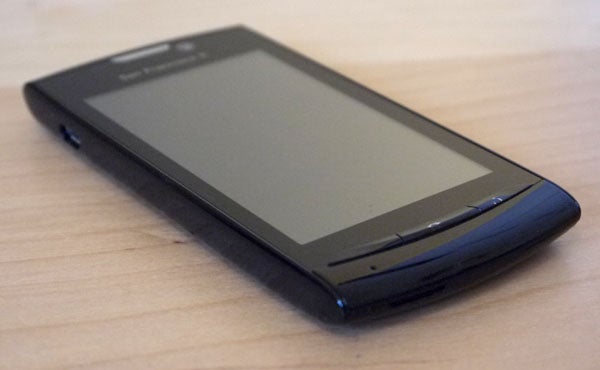
Verdict
Pros
- Large high res screen is great for web, email, etc
- LED flash makes camera more useful
- Provides proper smartphone experience for very little money
- Runs latest Android 2.3.5 OS
Cons
- Processor is slow
- Camera still quite poor
- Build is still very budget
Key Specifications
- Review Price: £99.00
- 3.5in, 480 x 800 pixel screen
- 800MHz processor
- Android 2.3.5 OS
- 5 megapixel camera with LED flash
The Samsung Galaxy S II may have won our award for phone of the year 2011 but the Orange San Francisco came very close to pinching the top spot, despite being a budget handset that sold exclusively on Pay As You Go with Orange. The reason we liked it so much was because it was incredibly cheap – just £99 – for a fully fledged smartphone with (crucially) a decent sized screen.
Now the San Francisco brand is back in the form of the Orange San Francisco 2 (or Orange San Francisco II if you prefer), which – you’ll never guess – also retails for just £99. Its key improvements over its predecessor are a faster processor (up from 600MHz to 800MHz) and an improved camera (up from 3 megapixels and no flash to 5 megapixels with one LED flash). Not enough to upgrade perhaps but for newcomers looking for a super cheap smartphone, these stats are enough to just about keep this phone within touching distance of the superfast premium models.
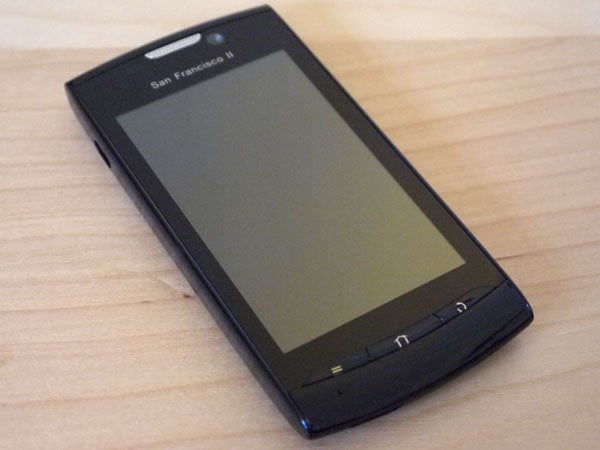
Sadly, one thing that hasn’t really improved is the design. The old San Francisco was hardly a bastion of brilliant design but it was smart enough, especially in its soft-touch grey garb. The equivalent finish on this new model may well have similarly improving effects but the glossy black version we’re reviewing doesn’t quite do it for us. The finish looks eternally grubby with fingerprints and the layout of features (buttons, speaker, etc) on the front isn’t the most elegant. By all means, it’s far from being out and out ugly, but it’s no looker either.
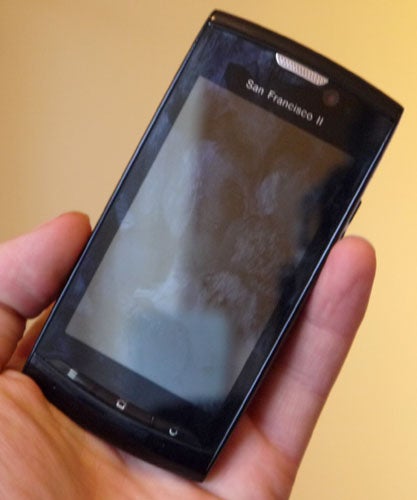
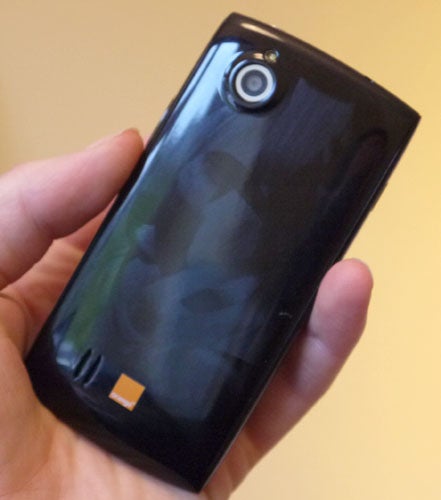
The Orange San Francisco picks up fingerprints with particular aplomb
Build quality is decent, though. While the glossy plastic will scratch fairly easily and the screen isn’t tough Gorilla Glass, the phone doesn’t feel inherently flimsy. The fit and finish certainly isn’t up to iPhone standards but there are no overly obvious gaps or other distractions to be concerned about, and all the buttons are reasonably responsive (if strangely labelled in the case of the front navigation buttons). The volume rocker and power buttons are a tad small and fiddly though.
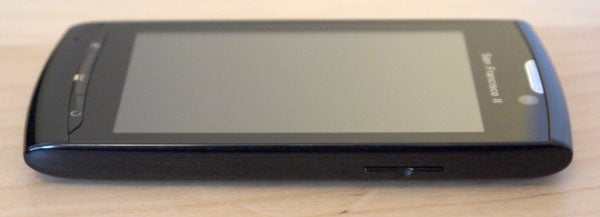
The phone feels pretty good in the hand too. Built around a 3.5in screen, its fairly modest proportions (117 x 58.5 x 10.6 mm) mean it’s easy to get a good grasp of the thing and its gentle curves make it comfortable as well. At 120g it’s fairly middling in the weight department.

On the connectivity front, all the basics are covered with a headphone jack on the top, a microUSB socket on the side and a microSD slot under the battery cover, which conveniently you don’t need to remove the battery to access. When you plug the phone into a computer a message pops up straight away to ask if you’d like to use mass storage mode, rather than invoking some unnecessary syncing software installation or such like. It’s a simple touch but plenty of other Android handsets don’t make it this easy, and of course Windows Phone handsets and iPhones require software before you can properly connect them to a computer and add files to them. Onboard storage is essentially nonexistent but you get a 2Gb microSD card preinstalled, and a 16GB microSD card can be picked up for peanuts.
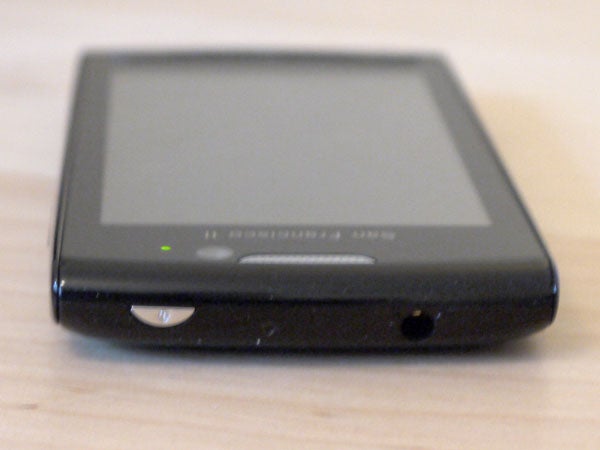
On the back is the camera along with its flash and there’s also a front facing one for video calling. The latter is very ropey quality but at least it’s there.

The Nokia Lumia 800 on the left has the Orange San Francisco 2 beat for brightness, contrast and colour saturation but the budget handset is actually sharper, so better for reading text.
Having both the San francisco II and the Nokia Lumia 800 to hand, what’s quite striking is the difference in the screen quality… and the San Fran comes out on top. Okay, maybe it’s not quite as clear cut as that but where the Lumia 800 has a brighter, more vivid display thanks to its AMOLED technology, the San Francisco 2’s LCD panel has it beat for sharpness (because of the Lumia’s use of a Pentile subpixel matrix). It’s also bright and colourful with good viewing angles. It’s not a match for the best displays (LCD or AMOLED) but crucially – and uniquely among such low priced handsets – it has a resolution of 480 x 800 pixels (the same as the original iPhone). Everything from reading emails and browsing the web to playing games and watching videos is just more fun and productive when you move from the super low-res 240 x 320 screens of other budget handsets to a display like this.
The San Francisco runs a Qualcomm MSM7227T processor, which is the same as its predecessor but this time it’s running at 800MHz rather than 600MHz. The result is a slightly more fluid experience, though we’re still talking about a fairly sluggish handset overall. Scroll around the interface and there’s a slight stutter to the animations that accompany you, and some apps can take a good while to load. Nonetheless, assuming you have a modicum of patience you can get by.
Probably the two biggest problem areas are gaming and web browsing. The former is limited by the modest graphics processor. Basic games like Angry Birds play well (just) but more graphically intensive games struggle. Similarly graphically rich websites will require patience as they take a while to load and can be slow to scroll around.
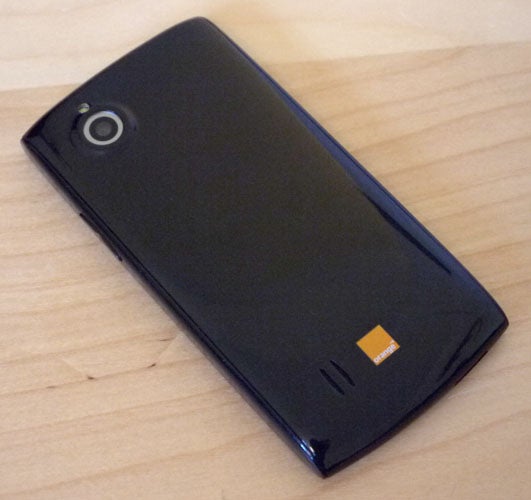
To put some numbers against that performance, we ran a couple of benchmarks: SunSpider and Browsermark. Both are platform independent browser based benchmarks so give a good basic level of the general responsiveness of a handset. As you can see from our chart below, the San Francisco II trails high-end handsets, such as the iPhone 4S and Samsung Galaxy Nexus, by some margin but it’s the likes of the previous San Francisco that the San Francisco 2 is competing with, and here it puts in a respectable performance.


Helping to keep performance in check is that this phone runs the 2.3.5 version of Android. Android 2.3 added noticeable performance improvements over previous Android iterations and the difference is crucial here. 2.3.5 is not the latest version available (that honour goes to 4.0 Ice Cream Sandwich, which is currently only available on the Samsung Galaxy Nexus) but it packs in all the essentials and is easy to get to grips with.
The homescreen arrangement is typical Android with five homescreens ready to fill with widgets, apps and shortcuts arranged with two either side of the central default screen. All the usual widgets (message viewers, picture viewers, contacts viewers, RSS readers) are available with a few extra Orange branded ones thrown in for good measure. None are worthy of note except for the Orange tips widget, which displays handy little tips for how to use your phone – a useful addition if you’re new to Android smartphones.
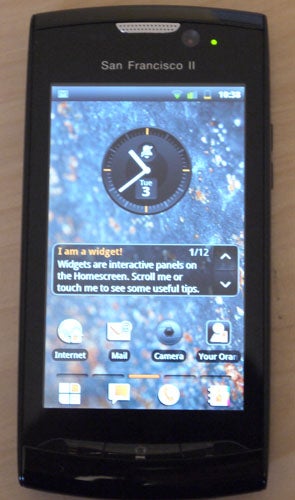
The Orange San Francisco II has an orangey theme but in terms of functionality it’s mostly standard Android 2.3.5.
Thankfully Orange hasn’t tried to be too clever by mucking about with the arrangement of the four icons that run along the bottom of each homescreen. They’re your standard useful collection of app menu, messages, dialler and contacts. Tap the app menu and you get to the full list of all your installed apps, which (again thankfully) Orange hasn’t messed about with so it’s just a simple alphabetic list.
On the whole, despite an Orangey colour scheme, Orange hasn’t tinkered about too much with the phones’ functionality so those of you hoping for a straightforward Android experience will be pleased. That said, there are a few other Orange additions.
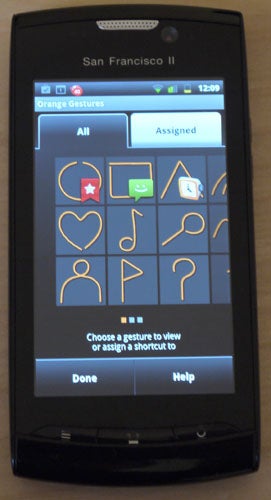
Gestures are a useful way to quickly open your favourite apps.
Orange Gestures allow you to open your favourite apps by simply drawing a shape on the screen. You could of course just ensure that all your favourites are kept within quick reach on your main homescreen but it’s always nice to have an alternative.
Orange Mail is a seemingly pointless alternative to the default email app. It adds a search tab and gives access to a number of different accounts, but it certainly doesn’t outsmart the default Android email app.
There’s also an app for keeping tabs on your Orange account, tracking your credit used and such like. It would be rather pointless for a premium contract phone but is a useful addition for this budget Pay As You Go handset. Also useful is Orange Signal Boost, an that app connects to your wireless router for improved
indoor coverage.
When it comes to your everyday tasks, this phone generally puts in a good performance. Contacts management is a cinch with it doing a good job of automatically matching information from your SIM, email accounts and social networking services. Call quality, meanwhile, isn’t exceptional but is perfectly adequate. The loudspeaker is fairly poor though.
Texting and emailing is a little time consuming due to the slightly sluggish response as you tap away on the otherwise excellent onscreen keyboard. Those used to blasting out dozens of words a minute may find they end up with rather a lot of gobbledygook, though again with a bit of patience you get the hang of it. Being an Android phone, the selection of supported email types is top notch and the app itself is a breeze to use.
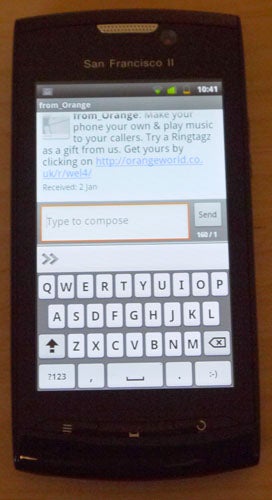
The keyboard on the Orange San Francisco II is a little slow but the layout is great.
We’ve already mentioned the sluggishness of web browsing but otherwise the experience is great. Pages are rendered correctly and it’s easy to zoom in and out of them, with the option to have text reformatted to fit the width of your screen. Flash is theoretically supported but as the phone is so slow you’re best leaving it off anyway.
When it comes to social networking, there’s not too much on this handset above and beyond the official Facebook and Twitter apps, and the contacts integration – so it’s no rival to Windows Phone in this regard – but it certainly doesn’t feel a chore just using the excellent official apps.
Mapping and navigation is taken care of by the standard GoogleMaps and Navigation apps that come with all Androids. The former is excellent for planning routes and finding your way on foot (GPS is of course onboard), while the latter does a reasonable job of car-based navigation duties. However, both require a data connection so don’t rival dedicated sat nav apps or Nokia Drive as found on the Nokia Lumia 800.
Of course, being an Android phone, the selection of apps is vast and so you should have no problems tracking down useful or entertaining ways to pass the time.
One thing downloading apps won’t help with, though, is playing video. While you can easily add support for just about any format you care to mention using extra apps, the slow hardware means you’re still fairly limited in what will play, with only low bit rate standard definition clips playing ball. Thankfully, music playback is rather better with an easy to use interface, a noise free headphone socket and plenty of volume on tap.
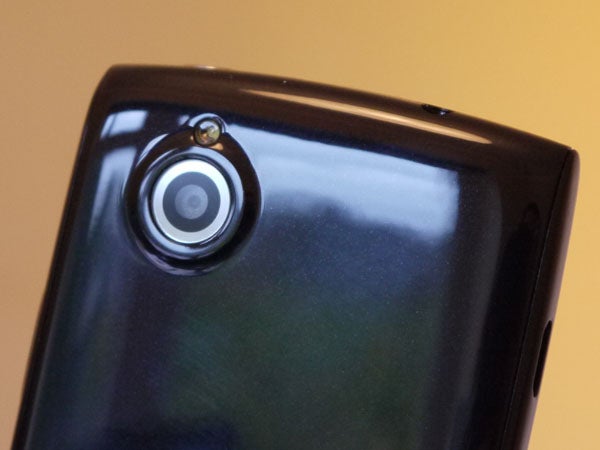
Shooting your own video is also a fairly limited endeavour too. You can capture up to VGA (640×480) resolution but only at 15fps according to our sample clip. Lower resolutions will shoot faster but you then end up with very low detail clips. You also can’t turn on the LED for shooting video.
Taking pictures isn’t much better as the camera simply doesn’t create very clear shots. All our test shots came out with muted colours and a general softness that was down to more than just the modest 5 megapixel resolution. It’s nice to see a slight upgrade from the previous model, especially with the LED flash now onboard but this is still very much a budget handset when it comes to photography.

It’s also a fairly budget model when it comes to battery life too, despite its slow processor. We found it regularly running dry well short of two days, so like with most smartphones a nightly charge is a must.
”’Verdict”’
The Orange San Francisco 2 continues the trend of its forbear in being the best ultra budget smartphone on the market. Sure, it doesn’t take great leaps ahead of its predecessor with its improved camera and processor still lagging well behind the majority of handsets. However, the majority of smartphones don’t cost £99 on Pay As You Go, and it’s here that the San Francisco 2 does exactly what’s needed. Uniquely for an ultra budget phone it delivers a large enough and high enough resolution screen to make for a satisfying smartphone experience, if you’ve a little patience. The only way it can be beaten is if you opt for a secondhand handset, but even then you’d be looking at a fairly old model for that sort of money.
How we test phones
We test every mobile phone we review thoroughly. We use industry standard tests to compare features properly and we use the phone as our main device over the review period. We’ll always tell you what we find and we never, ever, accept money to review a product.
Trusted Score
Score in detail
-
Performance 5
-
Camera 4
-
Design 7
-
Usability 8
-
Value 10
-
Features 6

